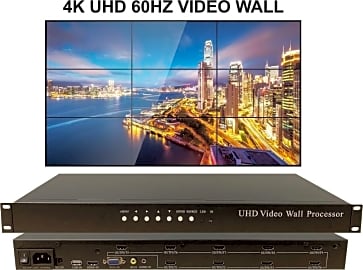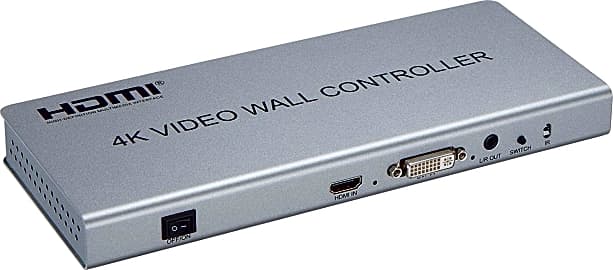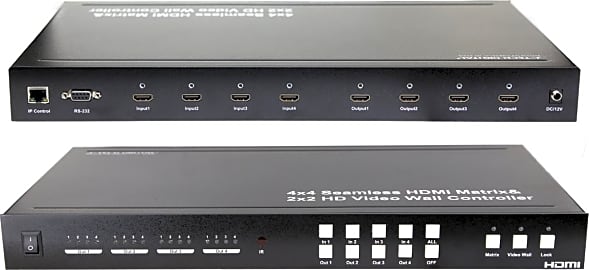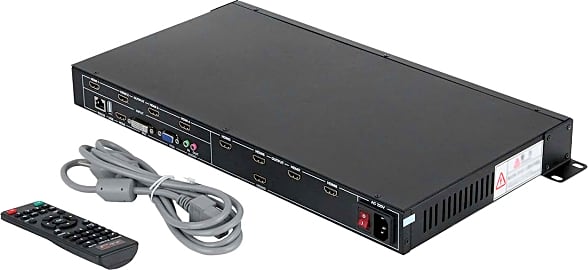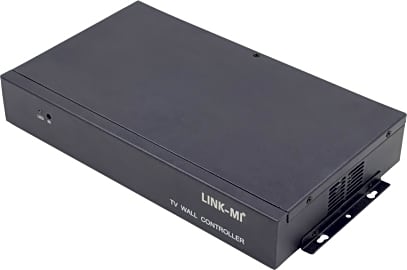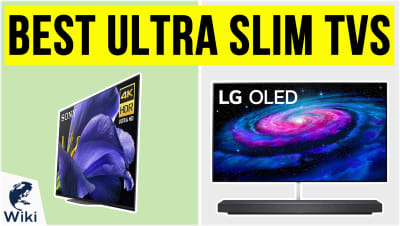The 10 Best Video Wall Controllers

This wiki has been updated 31 times since it was first published in October of 2017. If you find that one screen isn't big enough to convey your message, or you need centralized control over a number of televisions spread across a space, like a bar, you're going to want one of these high-quality video wall processors. They can take a signal, break it up, and render it seamlessly on up to nine TVs working in concert, or split it to share among several displays. When users buy our independently chosen editorial picks, we may earn commissions to help fund the Wiki.
Editor's Notes
November 16, 2020:
As with our last visit to this ranking, the drive toward additional models capable of handling 4K signals continues. To that end, we updated the Link-Mi LM-TV09, the layout of which is largely the same as its predecessor save for the elimination of support for VGA and composite video input. While this may alienate some users, HDMI connectivity is liable to dominate most setups, and the composite connection will continue fading into obsolescence in the coming years. In place of those connections, the TV09 has included a Displayport input, which should prove to be more useful in connecting most computers as sources for video content.
We also upgraded the Rijer 2X2 Processor to the Rijer Matrix Processor, taking you from a 2x2 maximum setup to a 3x3. One of the most important features of this model is its interlaced feed conversion, which prevents annoying lines from appearing in your image, especially during action scenes, by turning that feed into a progressive signal that plays much more fluidly on most modern televisions.
August 18, 2019:
For this latest ranking, we wanted to focus on controllers that could utilize and even output 4K signals, where our previous list only included models that offered up to 1080p. The Rijer unit on our old list has been replaced by a new offering from the same company that does, in fact, boast a 4K stream. No Hassle AV, which took a bit of a hit on our last ranking, has rebounded into first place with their 3x3 4K model. In our special honors section, you'll find three devices all capable of 4K display, two of which are rack-mountable and clearly geared toward the highest echelon of professional application.
October 22, 2018:
A new addition to the market, the Mophorn 3x3 made a big splash by offering all the same bells and whistles as similar units, while being both equally durable and more competitively priced compared to its competition. One such competitor, the No Hassle AV 3x3, took a dive as its remote has failed to live up to the company's name.
Special Honors
Exxact Corp TensorEX TS4 This offering comes from a company that boasts a whole host of large, rack mounted processors. This particular model offers outstanding color support from 4K sources, split up among four screens per card. It can be scaled up with as many as five additional cards to create an absolutely massive display. exxactcorp.com
RGB Spectrum 4K Processor With reliable copy protection capabilities and up to 60 preset layouts, you can set this option up quickly and easily without fear of many significant technical issues. It's a little more complicated when you get into manual settings, but a front-facing LCD readout makes adjustments relatively easy to perform. rgb.com
Smart AVI 4K This model provides users with an incredibly simple plug-and-play setup and a quality of video that's hard to beat. It can be controlled by a PC through its Ethernet connection, and its 2 x 2 output can be split up to deliver different inputs to up to four screens placed wherever you like. smartavi.com
The Birth Of Multimedia
Video technology has experienced a meteoric rise over its short lifespan.
Published a few months before the United States' first-ever color television broadcast, Ray Bradbury's 1953 masterpiece Fahrenheit 451 fantasizes about immersive, interactive, wall-to-wall video screens that threaten to replace most real human interaction. All social commentary aside, Bradbury could hardly have known how prescient he really was. It's taken over a half-century, but that experience is no longer the stuff of science fiction.
Video technology has experienced a meteoric rise over its short lifespan. And like an incredible number of other fundamental electrical inventions, Thomas Edison was deeply involved in its genesis. On an immediate level, his Kinetoscope foreshadowed a rich future for video recording. And while Edison was an undeniable engineering genius, he really only made one true contribution to the field of pure science. Known for decades as the Edison Effect, his renowned rediscovery of thermal electron emission paved the way for vacuum tubes, cathode rays, diodes, and transistors — all absolutely vital parts of the development of electronic displays.
Video spent much of the last century beaming out of a vacuum tube, courtesy of a hot cathode. The cathode-ray tube television operated on analog signals and provided America's entertainment du jour for generations. Engineers refined the CRT over many years, and by the end of its run, the glass behemoths delivered smooth motion, crisp lines, and brightness levels that kids these days can scarcely imagine.
By the time high-definition video hit the scene, CRTs were headed the way of the dinosaur; no one had the strength or space for a 45-inch tube TV that weighed a few hundred pounds. The first rear-projection big-screen models weren't much lighter than their predecessors, and they suffered from brightness and contrast issues. If we were ever going to realize Ray Bradbury's wallpaper-TV dreams, something had to give.
A Liquid Crystal Lunch
To solve the problem of overly massive television sets, engineers turned to a somewhat counter-intuitive, hybrid-state type of matter: the liquid crystal. And there's an overwhelming chance that you're looking at liquid crystals right now.
The light-emitting diode brought the weight and profile of LCD screens down considerably.
LCDs are basically sandwiches of liquid crystal between two layers of substrate. In the middle is an organic polymer that demonstrates characteristics of solids or liquids, depending on whether an electric charge is flowing through it. The most basic such panels consist of polarizing substrates offset 90 degrees from one another, surrounding a layer of twisted nematic molecules that bend the light and allow it to pass through both outer layers, resulting in a bright, activated pixel. Also lining the substrates are two opposing layers of thin-film transistors, which are transparent networks of transistors and capacitors, as well as a series of color filters. Most variants on this system change the orientation of either the substrates or the liquid crystals, which can greatly affect brightness, response time, and black levels.
One shortcoming of LCDs is that they aren't emissive, which means behind every good panel, there must be a source of light. Older flat-panels sat in front of ultra-bright fluorescent bulbs, which tended to bleed light, and were rather heavy and difficult to work with. The light-emitting diode brought the weight and profile of LCD screens down considerably. Some now incorporate entire layers of LEDs, with individually dimmable regions allowing for strikingly deep blacks and increased contrast. Edge-lit displays are becoming more popular, partially because they're so slim and lightweight, and this is the type of LCD you'll most likely see on commercial video walls.
There are also two relatively new technologies called OLED and MicroLED. Each pixel in a MicroLED panel is a grouping of multiple tiny LEDs of varying colors. Unlike a standard LCD screen, this type does produce its own light, and also doesn't require color filters. The entirely different OLED utilizes a series of layered organic (read: carbon-containing) substances that, when the electricity flows, separate local electrons from their anode hosts, and then essentially slam them back together. This sudden reunion spawns a photon, the building block of light, which passes through a color filter and shines itself into the room. Because, unlike backlit systems, there's only one step to power, OLEDs are among the most energy-efficient and fastest-responding displays on the market. On top of that, they're ridiculously thin and light, with some models less than a quarter-inch thick.
While it's possible to create a video wall out of everyday HDTVs, there are commercial-grade units built just for this purpose. They often include appropriate features like modular mounting systems, ultra-slim bezels, and power passthrough. After selecting the right set of displays, you'll need a reliable way to make sure they all receive the right signal.
What's Behind The Plugs
While some commercial models offer the ability to daisy-chain and stretch an input across multiple screens, this method is severely limited in terms of image quality and flexibility. Aside from that entry-level approach, there are a few other major types of video wall controller: hardware-, software-, and network-based. Software suites makes it relatively easy to program and maintain a small wall using a standard PC with added GPUs. Alternately, there are quite a few hardware options that function more like traditional A/V equipment. Many of these are rack-mountable, and operate on a fixed set of instructions. These can be powerful, but they can't usually be upgraded or future-proofed. AV-over-IP is a relatively new transmission method that uitilizes gigabit (or faster) Ethernet configurations to distribute processed data to multiple screens. This system is considerably more scalable and upgradable than the others, and continues to gain traction.
Display technology is among the most fascinating and rapidly advancing fields today. The proliferation of low-cost, high-resolution screens, along with cutting-edge, creative visuals and rendering techniques, make it an easier choice than ever to invest in a massive, multimedia experience, whether it's in an airport, art museum, or athletic stadium. Depending on your organization's size and the content on display, one of today's powerful controllers will make setting up your video wall a breeze.



